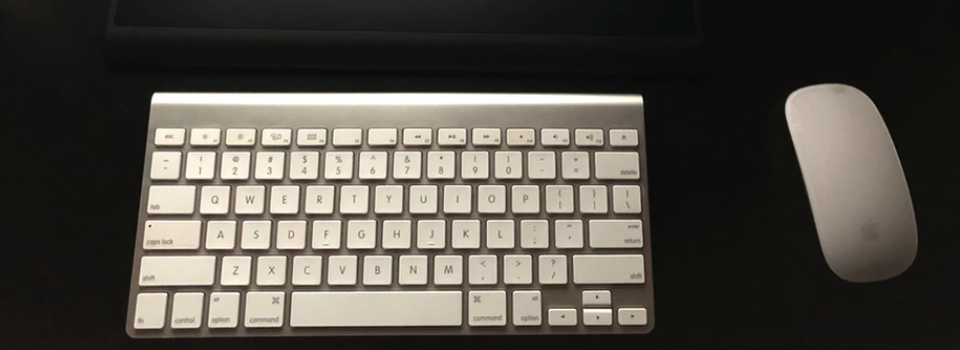Every MacBook comes with a built-in keyboard and trackpad, but these can often feel clunky and awkward to use.
If you’re craving the extra space of a full-sized keyboard, or you prefer the separate left/right buttons and scrolling wheel of an external mouse, then you could always purchase a wired keyboard and mouse – or you could go wire-free and purchase Bluetooth peripherals.
In this article I’ll share everything you need to know, in order to get any Bluetooth mouse or keyboard communicating with your Mac. Once you’ve setup your external keyboard or mouse, you may discover that it functions slightly differently to your Mac’s built-in keyboard or trackpad, so I’ll also be covering some essential ways that you can tweak each device’s configuration.
Turn on your Bluetooth
Before you can connect any device to your Mac over Bluetooth, you need to make sure that its Bluetooth is enabled!
If your Mac features a “Bluetooth” icon in its menu bar, then click this icon and select “Turn Bluetooth On.”

If your menu bar doesn’t contain a Bluetooth icon, then:
- Select the “Apple” logo from your Mac’s menu bar.
- Navigate to “System Preferences… > Bluetooth.”
- Select “Turn Bluetooth On.”
- While we’re here, you may also want to consider adding the Bluetooth icon to your Mac’s menu bar, so it’s always within easy reach. To add the Bluetooth icon, select the “Show Bluetooth in menu bar” checkbox.
Pair your mouse or keyboard
To pair your Bluetooth peripheral:
- Select the “Bluetooth” icon from your Mac’s menu bar, and then select “Open Bluetooth Preferences…” Alternatively, navigate to “System Preferences… > Bluetooth.”
- Check whether you need to manually enter “pairing mode” on your specific model of keyboard or mouse. Sometimes, this mode will be enabled by default, but it’s worth checking for any kind of “sync” button, or a power button that you need to press before the device starts actively looking for something to connect to. If in doubt, check the manual that came with your Bluetooth-enabled device, or consult its online documentation.
- Once the keyboard or mouse is in pairing mode, it should appear in your Mac’s “System Preferences… > Bluetooth” menu, along with an accompanying “Pair” button. Give the “Pair” button a click.
Your Mac should now wirelessly connect to your mouse or keyboard.
Configuring your Bluetooth mouse
Once you’ve connected your external mouse, you may discover that the settings that worked for your built-in trackpad aren’t quite right for your new, external mouse. For example, maybe you need to tweak the scrolling speed, or switch the primary mouse button.
To make changes to your mouse’s settings, select “System Preferences… > Mouse.”

From here, you can tweak the following settings:
- Tracking speed. This controls how fast, or slow the onscreen pointer moves across the screen. Move the tracking slider to the right to speed up the cursor, or left to slow things down.
- Scrolling speed. This is how quickly the page scrolls, when you roll the mouse’s scrolling wheel. When the scrolling speed is set to fast, you’ll race to the top of the page, and when it’s slow you’ll be able to view more content as you scroll the page in multiple, separate motions. For speedier scrolling, move the slider to the right; for slower scrolling, drag the slider to the left.
- Double-Click speed. You double-click by pressing your mouse’s primary button twice in quick succession. If you’re struggling to activate the double-click feature, then you can give yourself more time to press the button twice, by dragging the slider to the left. Alternatively, if you find yourself double-clicking by accident, then you may want to drag the slider to the left, at which point you’ll have to press the primary key twice almost immediately, before macOS registers it as a double-click.
- Primary mouse button. By default, macOS uses the left mouse button as the “primary button.” If clicking the right button feels more natural, then you can switch things around by selecting the “Primary mouse button: Right” radio button.
Configuring your Bluetooth keyboard
You can also make some tweaks to your Bluetooth keyboard, by navigating to “System Preferences… > Keyboard.” This menu contains plenty of options that are worth exploring in more detail, but some of the most important include:
- Key Repeat. This allows you to specify how fast a key should repeat. Drag the slider to the right and you’ll wind up with a string of the same letters each time you hold down a key for more than a split second. Alternatively, drag the slider to the “Slow” end of the scale, and your Mac will wait before repeating the same key. If you’re a slower typer, then you may want to disable the key repeat feature entirely, by dragging the slider all the way to the “Off” position.
- Delay until repeat. This option lets you specify how long you need to hold a key, before it begins repeating. If you’re not a particularly fast typer, then you may want to use a longer delay, as this allows you to press keys more slowly without accidentally printing the same character, over and over again.






Add Comment